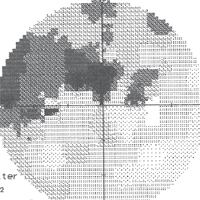 Twice-a-year visual field testing, compared to once-a-year testing, leads to earlier detection of glaucoma progression for high-risk patients, especially using global trend analyses, according to researchers at the Jules Stein Eye Institute.
Twice-a-year visual field testing, compared to once-a-year testing, leads to earlier detection of glaucoma progression for high-risk patients, especially using global trend analyses, according to researchers at the Jules Stein Eye Institute.
“This finding has significant implications for the care of patients with glaucoma,” the authors wrote in an article in the December issue of Archives of Ophthalmology.
Using data from the Advanced Glaucoma Intervention Study (AGIS), investigators gathered the visual field examinations of 468 eyes (381 patients) with primary open-angle glaucoma, which was no longer controlled by maximum medical treatment.
The researchers then created two data sets. The first set, which included twice-yearly AGIS field test results, was labeled as the high-frequency testing group. To create the second data set to represent low-frequency field testing, the researchers deleted every other test of the AGIS participants. The high-frequency group had a median of 20 visual field examinations and the low-frequency group had a median of 12.
“The high-frequency data set was more likely to detect progression with mean deviation or pointwise linear regression criteria,” they found.
More specifically, using mean deviation as a criterion, 43.6% (204 eyes) in the high-frequency data set progressed while 34.2% (160 eyes) in the low-frequency data set progressed. Alternatively, using pointwise linear regression as a criterion, 39.5% (185 eyes) in the high-frequency data set and 35.7% (167 eyes) in the low-frequency data set progressed.
“The hazard ratios for progression are large enough, especially for [mean deviation] criteria, for the benefits to be considered worth the extra time and expense required for earlier detection of glaucoma progression, at least in a subset of patients at higher risk of progression,” the researchers wrote.
While three examinations per year have been recommended for optimal detection of glaucoma progression, no evidence-based data supports such a recommendation, the authors wrote. And, they add, only a minority of patients have disease that progresses at a rate fast enough to justify thrice-yearly testing.
Such a “testing strategy is cumbersome and is not practical under most clinical circumstances,” they wrote. “Our data provide evidence for the advantages of a more practical six-month schedule for visual field testing.”
Nouri-Mahdavi K, Zarei R, Caprioli J. Influence of visual field testing frequency on detection of glaucoma progression with trend analyses. Arch Ophthalmol. 2011 Dec;129(12):1521-7.

